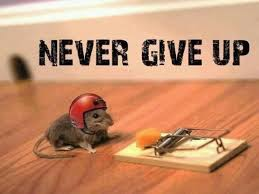
We have all had the experience. We try to contact donors and no answer. They will not answer the phone. They will not answer their email. They probably don’t open our mail. And the silence is deafening. Gabriel Luna-Ostaseski, founder of Upshift, has come up with something he calls “the rule of 7” for sales situations. We think this merits some consideration for major gift work.
He says, “It takes an average of seven times for someone to hear about something before they take action, yet the average sales person gives up after 1.7 to 2.1 call attempts. I figured that we needed to at least call them seven times, if not more. My own plight wasn’t always spectacularly easy, either (proof that being the Most Charming Person on EarthTM doesn’t always work with answering machines). It actually took me five weeks to get a call back.”
He talks about sending little gifts every week for a month without any response, but at the same time, continued his calling and contacting. Then, everything broke loose and he got a number of calls and responses, which made the whole effort worth it.
He goes on to say, “Not everyone (dare I say few?) will answer your calls at first. You’ll have to navigate your way past barriers like receptionists, assistants, switchboard operators, answering machines (I added spouses and gatekeepers) – a barrage of bureaucracy that can kill your sale before it even happens. That is, unless you’re prepared. This is not a sprint… it’s a marathon. So be prepared accordingly.”
This rule of 7 got me thinking about how easily I give up when I try to contact someone. I send one text or email or leave one message and truly believe that, (a) the person is immediately going to interact with me, and, (b) what I have to say must be at the top of their priorities. Neither of these is true.
The fact is that your donors are very busy people. Very busy. So, when your message arrives in their home or office, by whatever media you choose, it is most likely lost in all the other important things that are going on in that donor’s life. Which is why you have to try again. And again. The rule of 7.
And even when you get into a situation where the donor is frustrated, you keep moving forward, with a good and clear heart, and try again. Here’s a recent example from an MGO we work with.
Robert (not his real name) had been periodically reaching out to a donor he worked with. The donor was cool and distant. Then the donor said he was getting too much communication, so Robert backed off quite a bit. When the donor finally did give on January 19th, Robert did not know about it until March 18th because of internal data management system problems.
Robert immediately called to thank the donor. Needless to say, he was upset. Robert apologized. The donor then called back to make sure Robert knew he was upset. Obviously how Robert handled himself and represented the organization made an impact, because this letter from the donor showed up a few days later:
Dear Robert. Sorry if I came across to you a bit too confrontationally the other day on the phone. I want you to know that I have a great deal of respect for you (and others like you), who are actively – and I will assume passionately – involved in leading efforts to help the needy. Keep up the good – no, great – work! Last but not least, enclosed is a donation. The likelihood is that I will send more your way….”
This is a perfect example of moving ahead even when there is conflict and trouble.
Here’s why this rule of 7 and the “keep trying” advice is so good. It helps us remember that life is not just happening from our point of view – our plan – what we want when we want it. The donors are busy – they have their own journeys, troubles and reactions to circumstances that either keep them silent in their relationship with us, or, if they do engage, their circumstances or our treatment of them cause them to react with anger and hurt.
That is why frequency of communication and attempts are important. They increase the probability of an interaction. If you just contact the donor two times it is highly likely, given the way life runs, that those two attempts will fall into a life event or circumstance of the donor where she must choose to ignore you and deal with the other things that are pressing on her. Which is why you need to try again.
It has been helpful to me to remember that donors have a life and that I am not the most important thing they are thinking about when my attempt to contact them arrives in their home or office. If I keep that in mind – if you keep that in mind, you will increase your attempts and not get discouraged. Try it.
Richard






Persistence, and at various times, certainly is key in getting through to a donor. I have heard the “7 attempts” strategy before, and have applied it to donors I contact before assuming they just are not interested in meeting. In your experience, how long do you think something like this should play out?
Hi, Christina – it could easily run over two months, or even more. What if the donor is on an extended vacation or trip? There could be silence for quite a bit of time. I would not just do the 7 rule in 7 successive days, etc – neither would you. But think of it this way. Think of how you would handle a good friend and then apply that frequency and sequencing.
Hi Richard and Jeff,
As a new fundraiser I appreciate your sage advice here. It reminds me of a research project by a Harvard researcher when I was in the call center business. The study was testing for customer loyalty and found that, somewhat counter-intuitively, the customers who had had service problems in many cases turned out to be the most loyal. The driver behind this finding was that the service issue had caused the customer to be much more involved with the call center rep. Assuming the rep handled the problem well and professionally, a new relationship was born, and the customer now had a friend at the company to call. As a result they felt more loyal to that brand. So my friends and I used to joke that the best way to increase loyalty was to give poor service —-and then clean it up well!
So, as you say in your story with the donor letter, it appears the donor’s persistance coupled with a professional approach did impress the donor and a relationship was born despite the issues. The key was engagement with the donor. My take away was that sometimes a rocky start with a donor can lead to better things later—the key is to get them talking to you–engagement—and to keep the faith!
Bill
Excellent post and follow-up comments Richard. Thanks.
The 7steps strategy works for every one who will day the persist. Even Jesus said that a man will fail,7*7times and be able to rise again if he dare to try again. Thanks RIchard. You post and information you share on Non profit is Timeless. Keep them coming.